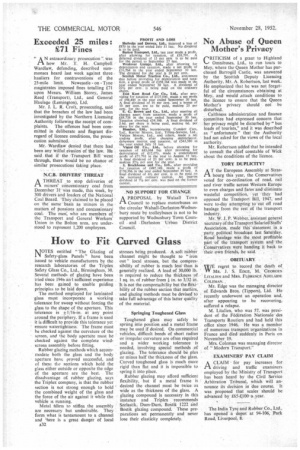How to Fit Curved Glass
Page 34

If you've noticed an error in this article please click here to report it so we can fix it.
MOTES entitled "The Glazing of 1'4 Safety-glass Panels" have been issued to vehicle manufacturers by the research laboratories of the Triplex Safety Glass Co., Ltd., Birmingham, 30. Several methodsof glazing have been tried since 194t ant sufficient experience has been gained to enable guiding principles to be laid down.
The method employed for laminated glass must incorporate a working tolerance for sweep without forcing the glass to the shape of the aperture. This tolerance is ±1/16-in, at any point around the periphery. If a frame is used • it is difficult to provide this tolerance yet ensure watertightness. The frame must be checked against the curvature of the • screen, and the body aperture must be checked against the complete wind screen assembly before fitting.
Rubber glazing methods which accom modate both the glass and the body aperture have proved successful, and of these the sections which hold the glass either outside or opposite the edge of the aperture are the best. The disadvantage of rubber glazing, says the Triplex company, is that the rubber section is not strong enough to hold the combined weight of the glass and the force of the air against it while the vehicle is running.
Metal fillets to stiffen the assembly are necessary but undesirable. They form. what is tantamount to a channel and 'here is a great danger of local stresses being produced. A soft rubber channel might be thought to "iron out local stresses, but the compressibility of rubber is much less than is generally realized. A load of 30,000 lb. ' is required to reduce the thickness of 1 sq. in. of rubber from in. to 3/32 in. It is not the compressibility but the flexibility of the rubber section that matters, and glazing methods must be devised to take full advantage of this latter quality of the material.
Springing Toughened Glass Toughened glass may safely be sprung into position and a metal frame may be used if desired, On commercial vehicles, difficult bends of short radius or irregular curvature are often required and a wider working tolerance is needed, involving special methods of glazing. The tolerance should be plus or minus half the thickness of the glass. Curved toughened glass is much more rigid than flat and it is impossible to spring it into place.
Rubber glazing may afford sufficient flexibility, but if a metal frame is desired the channel must be twice as wide as the thickness of the glass. A glazing compound is necessary in this instance and Triplex recommends Seelastik, Dum-DuM, Bostik 1222 and Bostik glazing compound. These preparations set permanently and never lose their elasticity completely.




















































































